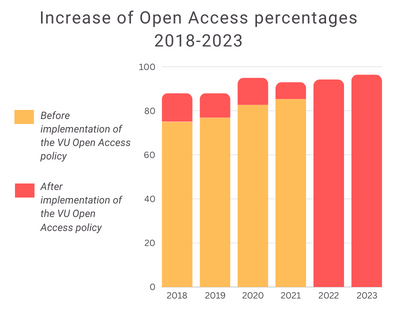The increase in 2023 is primarily due to the share of 'gold open access,' in which articles are published as Open Access after a fee is paid by the author, the university or the research funder.
Towards 100% Open Access
The increase in the share of Open Access publications from previous years—by an average of 9.75 percentage points!—is due to the VU Open Access policy, which aims to make as many existing and new publications as openly accessible as possible. After six months behind a paywall, the University Library makes publications openly accessible via the VU Research Portal, a method known as the 'green route.' For more information about VU's Open Access policy and the gold, diamond, and green 'routes,' visit vu.nl/openaccess.
But what about the books?
With nearly all articles becoming openly accessible, where do the biggest challenges lie? According to Anne van den Maagdenberg, Open Access Librarian at the University Library, there is still much to be gained in making books openly accessible. Does she have any tips for researchers who want to publish their books Open Access? "My first advice: look for a Diamond Open Access book publisher. With these publishers, you don’t have to pay to make your work open. A good place to start would be the list of publishers we have supported with the VU Open Access Innovation Fund."
Why open?
Making publications openly accessible is an important aspect of the move towards Open Science. The principles of Open Science are widely supported globally and are also reflected in open publishing. Making your scientific work available through Open Access has several advantages:
- It ensures equal access to knowledge for everyone.
- It broadens the visibility and impact of your work.
- It accelerates the reuse of your work, thereby promoting innovation.
- It increases transparency and builds trust in science.


